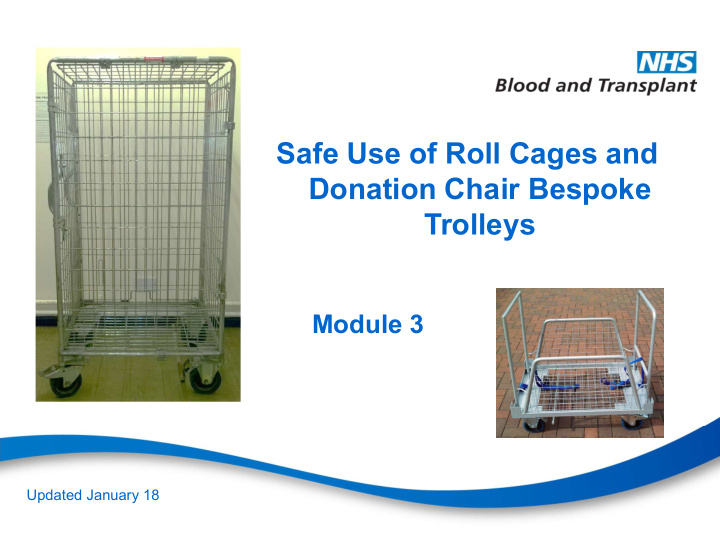



Safe Use of Roll Cages and Donation Chair Bespoke Trolleys Module 3 Updated January 18
Course Aims Aim: To be safe and competent at moving and handling roll cages and donation chair trolleys Learning Outcomes: •Identify the hazards and causes of accidents relating to the use of roll cages/ trolleys • Understand the ways to reduce the risks involved with moving and handling roll cages/ trolleys • Able to demonstrate manoeuvre roll cages/ trolleys in line with the Safe Systems of Work (SSW)
Roll Cage/ Trolley Incidents By Directorate April 17 - September 17 70 62 60 50 40 30 14 20 3 10 0 Blood Donation Blood Manufacturing and Group Services (GS) Logistics
Central South Roll Cage/ Trolley Incidents 0 1 2 3 4 5 6 7 8 Cheshire and Merseyside Central West 5 Cumbria and North East 3 1 Hospital Services 2 HR Operations 4 Kent and East Sussex By Department April 17 - September 17 3 Lancashire 5 Manufacturing 3 North Anglia 5 Sheffield and Leicester Sheffield and Nottingham 3 4 1 Solent South Anglia 4 South Midlands 6 Surrey and West Sussex South West 7 6 5 Testing 1 Transport Warehousing 2 West Midlands 2 Yorks and Humber 5 2
Exercise
Reducing Accidents • Improve stability by placing heavy items • All cages are labelled with what they should at the bottom of the cage contain – check and change if necessary • Reduce chances of articles falling by • Make sure trolleys are stacked correctly and having no loose items on top components are strapped in prior to moving • Eliminate tilting and tipping the cage or • All cages and trolleys are subject to regular trolley over uneven surfaces by using inspections and maintenance so report any ramps and all defects • Always have 2 People similar size and • Everyone receives training and should stature per cage – more for slopes follow it • Always ensure effective communication • Active supervision of the unload to ensure between staff prior to moving cages or SSW is followed adjusting cage position. • Manual Handling Risk assessments for • Always apply proper restraint as challenging venues appropriate i.e. brakes and lanyards • Look out for each other and help each other • Use the handles to steer the cage to where possible. reduce forces required when turning • Staff should be wearing correct PPE
To push or pull? Pushing Pulling • Manufacturers and HSE • Heels and ankles easily advise pushing caught • Twisting to see route • Slips: roll cage is moving away • Lower risk of catching feet and ankles • Better posture • Less likely to tip Posture - feet well spaced and Posture : feet close hands high for pushing together and hands low for pulling
Trolleys Push from Guide with curved square handle end handle end 8
Loading/Unloading the Trolleys - Lower Frame 9
Loading/Unloading the Trolleys – Upper Frame 10 10
Loading/Unloading the Trolleys – Seat • Vertical • Horizontal • Moving from vertical to horizontal demonstration 11 11
Hands on – Trolleys Time to practice removing chairs from the trolley and setting up.. 12 12
Trolleys on Tail-lifts 13 13
Demonstration and Practical Exercise
Course Aims Aim: To be safe and competent at moving and handling roll cages and donation chair trolleys Learning Outcomes: •Identify the hazards and causes of accidents relating to the use of roll cages/ trolleys • Understand the ways to reduce the risks involved with moving and handling roll cages/ trolleys • Able to demonstrate manoeuvre roll cages/ trolleys in line with the Safe Systems of Work (SSW)
Recommend
More recommend